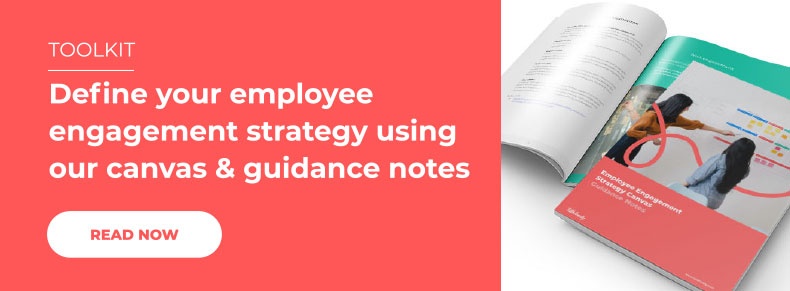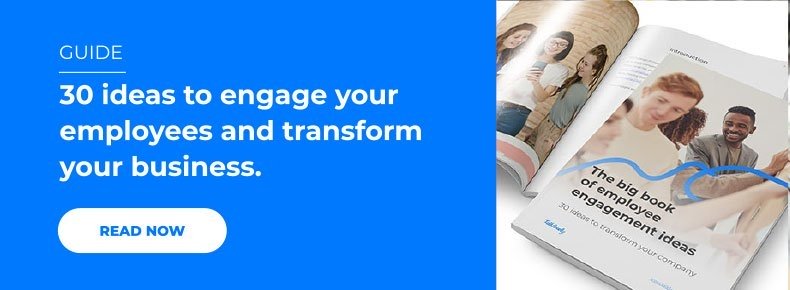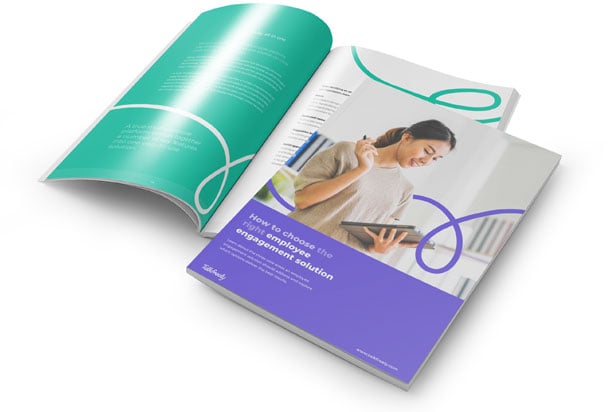The world of work has changed beyond recognition. And employee engagement strategies need to change along with it. With hybrid working now the norm, it’s time to rethink how we communicate with our employees.
Employee engagement strategies are big business. Businesses plough considerable time and money into generating strategies for employee engagement. And for a good reason. Since the 1990s, study after study has revealed that making an effort in employee engagement practices yields measurable results. Conversely, disengaged employees can be highly damaging to an organisation. According to Gallup, low engagement levels result in 37% higher absenteeism, 18% lower productivity and 15% lower profitability. We need strategic employee engagement practices in place to connect our hybrid workforce.
How can we choose the right employee engagement strategy for 2022? We have to throw the traditional rule book out of the window. In the past, the focus has been firmly placed on work engagement. The aim was to encourage employees to work more effectively and productively. Now, we have a different goal in our sights. We need to find a way to connect remote workers and office-based workers with each other and their managers. And we need to find a way to reconnect them with the organisation as a whole. Employee engagement trends are pointing towards restoring that vital relationship between employees and their company.
In this blog, we’ll be exploring what’s involved in creating successful employee engagement strategies. We’ll look at the research needed, the factors to consider, and how to incorporate the shifting ground of today’s business landscape into your plans.
What does an employee engagement strategy need to do?
Let’s get back to basics. When you’re developing your employee engagement strategy template, you must ensure your plan covers all the essential elements. Your strategy for employee engagement will be required to act as a framework for your employee engagement ideas and action points. This simple four-step plan will set you on the right track:
1. Define your objectives
Set out the objectives of the strategy based on the aspects of relevant employee engagement theory.
2. Establish a baseline
Tie down a firm 'baseline' within the workforce regarding engagement, motivation and satisfaction.
3. Create an action plan
Plan out a set of activities and actions to increase engagement with the workforce.
4. Measure outcomes
Track and evaluate the results of your strategy, both quantitatively and qualitatively.
The details behind employee engagement strategies can be difficult to ascertain when dealing with soft measures such as positive attitudes and connections. While there are challenges, all the research emphasises the importance of people analytics. They may not be perfect, but committing to various methods (such as online surveys, focus groups and team discussions) gives more accurate results, which can then be used to refine the strategy further.
Employee engagement strategies: Why is research so important?
Strategies of employee engagement require two pieces of research: one on engagement models; and one on the characteristics of the workforce. These will provide vital data to inform employee engagement strategy ideas and content.
There are many drivers of employee engagement, and so there are just as many solutions and engagement strategies available to organisations. Business leaders should look at the research available - from models on job satisfaction to those on individual psychology - and retrieve what is relevant to prepare strategies to raise levels of employee engagement. New consideration will need to be given to the hybrid working arrangement, exploring the tensions between working from different environments.
When you’re considering how to measure employee engagement, you need to make sure you’re using a tailor-made approach. Each organisation's workforce will be unique, which is why it is so essential to understand its characteristics. Hard data can be retrieved from employee engagement survey results on job satisfaction, motivation, working relationships and what is meaningful to people in their jobs and careers. We need to understand how our employees are really feeling before we can engage with them effectively.
The influence of the wider environment on strategic employee engagement
No business strategy operates in a vacuum; it adapts to changing circumstances within and outside the organisation. This has never been more apparent than now. The pandemic forced businesses to close their doors and move to a remote working environment.
This not only forced employees to adapt to new ways of working. It also left them searching for that all-important sense of belonging as they found themselves suddenly cut off from their peers and managers.
Now, as the offices become populated again, we have a new problem to consider. How to connect our office-based workers with those working from home? And with hybrid working becoming the norm, we need to explore the impact that this new arrangement has on our existing employee engagement model. Employees need to feel part of the organisation, and any employee engagement strategy plan for 2022 should address this as a priority. Your aim should be to nurture the emotional connections between employees and their workplace.
How to implement this into your strategy? The key to creating a sense of belonging starts with the employee voice. By giving your employees a chance to speak out and be heard, you’re empowering them to buy into your corporate efforts on a personal level. Think about employee engagement initiatives such as collaborative problem-solving, company-wide recognition programmes and online discussion platforms. Your aim is to give each team member greater autonomy to be part of the solution.
The best employee engagement strategy is tailored
Every organisation is unique. Therefore there is no one-size-fits-all solution to employee engagement strategies. Using information about the organisation, the workforce and the business environment allows you to prepare a bespoke engagement strategy. A tailored approach will always yield the best results. The drivers of employee engagement and motivation will differ from company to company, and engagement strategies need to adapt to these unique needs.
Engage for Success, a voluntary employee engagement movement in the UK, suggests that organisations need to produce initiatives that focus on individuals and teams. Employee engagement strategy examples reveal that this level of detail allows an action plan derived from the strategy to have varying priorities. As an example, analysis may suggest that the top issue is that employees like their jobs but don't understand how they contribute to their employer's success. A prioritised action point could therefore revolve around messaging on the company's key objectives, followed by team meetings to discuss how people contribute to organisational success.
This is particularly relevant in 2022. Strategies to raise levels of employee engagement need to take on that personal touch if they’re going to hit home. Explore how your employees feel in relation to health, wellbeing, diversity and employee experience, and then adapt your staff engagement strategy to address any problem areas directly.
You will also need to explore the impact of hybrid working on levels of employee engagement and retention. Resignations hit an all-time high after the pandemic, as job satisfaction plummeted and people started reevaluating their work-life balance. By tailoring your strategy for employee engagement to this new situation, you’ll find that retention levels begin to improve.
The role of technology in successful employee engagement strategies
When it comes to technology, now is the time for organisations to do things differently. According to Deloitte’s Global Human Capital Trends survey, traditional ways of engaging and communicating with employees are on the way out. Respondents said that they felt that work-based social media, collaboration platforms and instant messaging would increase in terms of use. Technology is essential to keep up with employee engagement trends and improve communications, which are vital in employee engagement strategies.
If people are so attached to going online and using social media, there should be a way for their employers to use this attachment in the 'inform and engage' elements of their strategies. While face-to-face working relationships are still very important, delivering on part of a company's strategy will be much quicker if online routes are made available to remote workers. Employee engagement strategy examples show time after time that this is the route to success.
This is why a good employee engagement strategy template is so important. Technology such as an employee engagement platform will assist in the speed of communications in a way that resonates with a high proportion of the workforce. A good employee engagement app can break down barriers and help you connect with those hard-to-reach employees.
An equally vital part of HR strategies to raise levels of employee engagement also involves accurate measurement of engagement levels before and after the action plan is carried out. Using the right platforms makes it easier to evaluate effectiveness and adapt your strategy as required. An employee app will allow you to gather people metrics and evaluate throughout the strategy will ensure that what is being done is the right fit for that particular organisation's situation and needs. To improve employee engagement, you need to measure and adapt your strategy as you go.
Your strategy for employee engagement: The focus for 2022 and beyond
Hybrid working has changed the face of business as we know it. In many ways, it offers a significant improvement to our employees’ lives. However, it does create additional communication barriers that need to be overcome. Strategic employee engagement is all about facing the challenges of the moment.
In these turbulent times, the need for a solid employee engagement strategy is more vital than ever before. We need to focus on long-term strategies that not only make good business sense but also make good employee sense. With our workforce currently so disconnected and fractured, we need to find a coherent strategy to bring our employees back into the fold. Our employee engagement activities should focus on rebuilding relationships and maintaining connections. In 2022, the right employee engagement strategies will connect and reunite.










